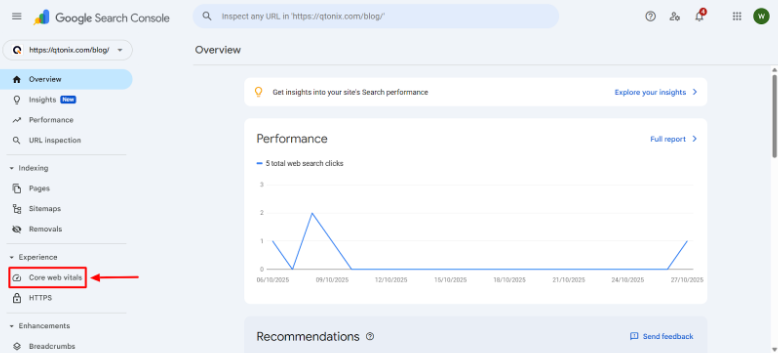How to Fix Core Web Vitals with Free Tools (Step-by-Step Guide)
In today’s rapidly changing digital environment, user experience (UX) is a significant factor in your site’s success. Google’s Core Web Vitals are at the heart of that — measurable metrics that evaluate how users experience your site in real-world conditions.
If your site is slow, unstable, or takes too long to respond, it doesn’t matter how good your content is — visitors will bounce. Thankfully, as a free tool, Google Search Console provides all the tools you need to identify and fix Core Web Vitals issues effectively.
In this blog, we’ll break down step-by-step how to fix Core Web Vitals using Google Search Console and improve your rankings, conversions, and overall website health.
Steps to Fix Core Web Vitals with GSC
Here are the key steps of fixing Core Web Vitals using Google Search Console
Step 1: Go to Google Search Console
Open GSC and then in the left sidebar, click “Experience” → “Core Web Vitals”.

Step 2: Select “Mobile” or “Desktop”
You’ll see two reports:
- Mobile
- Desktop
Each report shows:
- Good URLs
- Needs improvement
- Poor URLs

Step 3: Open PageSpeed Insights (PSI)
Go to https://pagespeed.web.dev/ and then focus on the “Opportunities” and “Diagnostics” sections for specific fixes.

Step 4: Validate Fixes in GSC
After implementing fixes, go back to Search Console → Core Web Vitals.
- Click the “Validate Fix” button next to the issue.
- Google will recheck the pages over 28 days.
- Status will change from:
“Validation started” → “Passed” or “Failed”
Bonus Tip: Use Free Tools Alongside Google Search Console
While GSC is great for diagnostics, pairing it with other free tools gives deeper insights:
- PageSpeed Insights: Detailed per-page analysis.
- Lighthouse (in Chrome DevTools): Local lab testing and performance audits.
- WebPageTest.org: Advanced performance breakdowns.
- Chrome UX Report (CrUX): Field data from real users.
These tools help you pinpoint the why behind poor metrics and validate fixes faster.
Conclusion
Resolving Core Web Vitals via Google Search Console is not rocket science — it just requires a bit of work and the ability to pay attention to detail.
Start off by using the Core Web Vitals report, note the highest quantity of issues, exit the report, and begin testing impacted URLs in PageSpeed Insights. Make targeted fixes by focusing on LCP, INP, and CLS. Only when you are finished applying all of your changes will you check your GSC account, validate your changes, and regularly monitor.
By keeping an eye on your Core Web Vitals, you are not simply optimizing for Google; you are creating a fast and enjoyable experience for users. That is what great SEO is all about.
FAQs
Once you click “Validate Fix” in Search Console, Google usually takes 2–4 weeks to re-evaluate your pages. During this time, you’ll see the status change from “Validation started” → “Ongoing” → “Passed” (if successful).
Here are the target benchmarks:
- LCP (Largest Contentful Paint): ≤ 2.5 seconds
- INP (Interaction to Next Paint): ≤ 200 milliseconds
- CLS (Cumulative Layout Shift): ≤ 0.1
Scoring within these ranges means your site delivers a fast and stable experience to users.
Absolutely! Core Web Vitals are part of Google’s Page Experience ranking signals. Sites that score well on these metrics tend to have better search visibility, higher engagement, and lower bounce rates.
To improve LCP:
- Compress and resize large images.
- Use faster hosting or a CDN.
- Minify CSS and JavaScript files.
- Preload critical resources like fonts or hero images.
Written by Adam Gibbs
Adam is a skilled SEO content expert with a proven track record of crafting high-quality, keyword-rich content that drives traffic, engages readers, and ranks on search engines. With 10+ years of experience in digital marketing and content strategy, Adam specializes in creating blog posts, website copy, and marketing materials tailored to both audience needs and SEO best practices.
Related Posts
How to Build UTM Parameters via Google Tag Manager?
Step-by-Step Guide to Creating a Meta Lead Generation Campaign
- All Posts
- SEO
Mastercopy Table of Contents Book Intro Call Case Studies Share: Related Guides: Related Posts SEO Beyond Keywords: Why Schema Markups...
Mastercopy Table of Contents Book Intro Call Case Studies Share: Related Guides: Related Posts SEO Beyond Keywords: Why Schema Markups...
Mastercopy Table of Contents Book Intro Call Case Studies Share: Related Guides: Related Posts SEO Beyond Keywords: Why Schema Markups...
Mastercopy Table of Contents Book Intro Call Case Studies Share: Related Guides: Related Posts SEO Beyond Keywords: Why Schema Markups...

